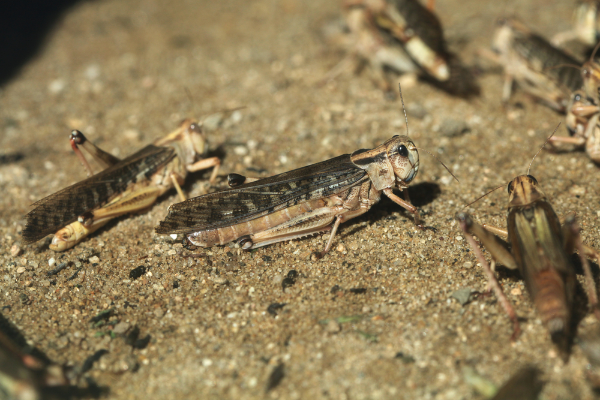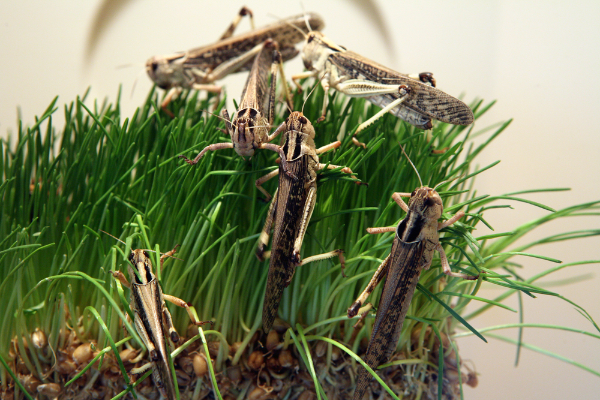The desert locust is known for being one of the most destructive pests in the world. They are capable of traveling up to 100 miles in a day, and can eat their own weight in food each day. In this blog post, we will discuss the history, life cycle, and management of the desert locust. We will also explore how farmers and governments around the world work together to prevent these pests from causing massive destruction.

Desert Locust Description
Desert Locusts (Schistocerca gregaria) are a species of short-horned grasshopper. They are highly migratory and form swarms that can number in the billions. Desert Locusts have a wide range in Africa, Asia, and the Middle East. They grow to about 2 inches in length and are characterized by their long hind legs, which they use for jumping. Desert Locusts are capable of flight and can travel long distances in search of food. When they find a suitable food source, they will lay eggs and form large swarms. Swarms can cover an area of several square miles and can contain up to 80 million locusts per square mile. Desert Locusts are known to cause damage to crops and pastures, and can lead to famine if left unchecked. In addition to their impact on agriculture, Desert Locusts can also be a nuisance to humans, as their loud chirping noise can be heard from up to half a mile away. If you see a Desert Locust swarm, it is important to report it to authorities so that steps can be taken to control the population.
Desert Locust Habitat
Desert Locusts are a species of short-horned grasshopper that is found in the desert regions of Africa, the Middle East, and Asia. The locusts are highly nomadic and can rapidly colonize new areas, making them a major agricultural pest. Desert Locust populations often go through cycles of swarming and non-swarming phases. During the swarming phase, the locusts form large migrating bands that can travel up to 150 km per day and consume vast quantities of vegetation. The non-swarming phase is characterized by small, stationary groups of locusts that do not migrate. Desert Locusts breed in dry, sandy soils and are most commonly found in arid or semi-arid environments however, they have also been known to breed in wetter habitats such as floodplains and agricultural land. Desert Locusts are a major agricultural pest and can cause widespread crop damage. They are capable of destroying crops, grazing lands, and natural vegetation over vast areas. Desert Locust control is typically done with a combination of chemical and biological control measures.
Desert Locust Diet
Desert Locusts are migratory pests that can have a significant impact on agriculture. Their diet is mainly composed of grasses and other plants, but they will also feed on insects, small mammals, lizards, and snakes. In times of scarcity, Desert Locusts have been known to eat clothing, leather, and even dry excrement. Desert Locusts are capable of consuming their own body weight in food per day, and a swarm can consume enough food in a day to feed 35,000 people. While Desert Locusts typically only cause damage during outbreaks, when swarms can number in the billions, their potential impact on food security is significant. As a result, monitoring Desert Locust populations and understanding their dietary habits is critical for mitigating the risk they pose to agriculture.
Desert Locust Size
Desert Locusts are large insects that can grow up to 7 cm long. They are usually yellow or brown in color, but their colors can vary depending on their stage of life. Desert Locusts typically live in arid or semi-arid regions, but they can also be found in wetter areas during times of drought. Desert Locusts are known for their ability to form huge swarms that can cover large areas of land. These swarms can be extremely damaging to agriculture, as the locusts can consume vast quantities of crops and grasses. Desert Locusts typically eat plants, but they have also been known to eat other insects, lizards, and even small mammals.

Desert Locust Lifespan
Desert Locusts are a type of grasshopper that is found in arid and semi-arid regions around the world. They are highly migratory, and can travel long distances in search of food. Desert Locusts have a relatively short lifespan, and typically only live for around 6-8 months. However, during times of high population density, they can survive for up to 12 months. Desert Locusts are an important food source for many animals, and their short lifespan ensures that there is always a fresh supply of food available. In addition, Desert Locusts play an important role in the ecosystem by aerating the soil and breaking down dead vegetation.
Desert Locust Behavior
Desert Locusts are a species of locust that is known for its ability to form massive swarms. These swarms can span vast distances and contain billions of individual locusts. Desert Locusts are primarily found in arid regions, but their swarms can travel great distances in search of food. When conditions are right, Desert Locusts can rapidly reproduce, forming new swarms that can devastate crops and cause widespread famine. Desert Locust behavior is largely dictated by environmental conditions. For example, Desert Locusts will only swarm when there is enough food available. If food is scarce, Desert Locusts will remain in their solitary state. As a result, understanding Desert Locust behavior is essential for predicting and preventing future swarms.
Desert Locust Speed
The Desert Locust is a species of locust that is known for its ability to travel great distances in a relatively short amount of time. Some Desert Locusts have been known to travel up to 100 miles in a single day. This is due to the Desert Locust’s long wings and powerful flight muscles, which allow it to cover large areas in a short period of time. As a result, the Desert Locust is one of the fastest flying insects in the world. Additionally, the Desert Locust is known to use thermals, or updrafts of warm air, to help it stay aloft for long periods of time.
Desert Locust Hunting
Desert locusts are species of grasshopper that are highly migratory and can form large swarms. These swarms can cause significant damage to crops, and so Desert Locust hunting has been employed as a means of pest control. Desert Locusts typically hunt in the early morning or late afternoon, when the temperature is cooler. They will use their sense of smell to locate their prey, which is usually grasshoppers or other small insects. Once they have found their prey, they will pursue it until they are within range, at which point they will strike. Desert Locusts typically eat around two grams of food per day, which is about 50% of their body weight. They will drink water if it is available, but they can also get moisture from the food they eat. Desert Locust hunting generally takes place in areas where there is a high density of Desert Locusts, such as agricultural areas. The hunts typically last for several days, during which time the hunters will try to kill as many locusts as possible. After the hunt is over, the area is typically sprayed with insecticide to kill any remaining locusts.
Conclusion
Desert locusts are the most dangerous migratory pest in the world. They can travel up to 100 miles a day and consume everything in their path, including crops and other vegetation. While they typically stay in deserts or semi-arid areas, when conditions are right they can form into massive swarms that can devastate entire regions. In this blog post we’ve looked at some of the basics of desert locust behavior – what causes them to swarm, how far they travel, and what damage they can do. If you live in an area where these pests could potentially cause damage, it’s important to be prepared.
Frequently Asked Question

